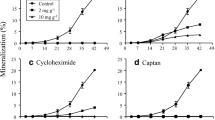Abstract
Bioluminescence-marked cells of Pseudomonas fluorescens were inoculated into soil by introduction into pores of two different size classes (< 6 and 30–60 μm neck diameter). Partial chloroform fumigation resulted in a differential killing of cells depending on the placement of the inoculum within the soil pore network and on the period of fumigation. Reduced survival was associated with increasing periods (30–120 min) of fumigation, and with inoculum placement into larger rather than smaller pores. Comparison of the effects of partial fumigation on cells introduced into four soils of contrasting pore-size distribution highlighted the need to calibrate the method on the basis of air/water-filled pore space and chloroform diffusion dynamics for different soil types. It is proposed that partial fumigation facilitates spatial characterisation of the distribution of bacterial cells introduced into soils.
Similar content being viewed by others
References
Adu JK, Oades JM (1978) Physical factors influencing decomposition of organic mateirals in soil aggregates. Soil Biol Biochem 10:109–115
Amin-Hanjani S, Meikle A, Glover LA, Prosser JI, Killham K (1993) Plasmid and chromosomally encoded luminescence marker systems for detection of Pseudomonas fluorescens in soil. Mol Ecol 2:47–54
Bartlett JR, Doner HE (1988) Decomposition of lysine and leucine in soil aggregates: Adsorption and compartmentalization. Soil Biol Biochem 20:755–759
Crozat Y, Cleyet-Marel JC, Corman A (1987) Use of the fluorescent antibody technique to characterise equilibrium survival concentration of Bradyrhizobium japonicum strains in soil. Biol Fertil Soils 4:85–90
Darbyshire JF (1976) Effect of water suctions on the growth in soil of the ciliate Colpoda steini, and the bacterium Azotobacter chroococcum. J Soil Sci 27:369–376
Darbyshire JF, Griffiths BS, Davidson MS, McHardy WJ (1989) Ciliate distribution amongst soil aggregates. Rev Ecol Biol Sol 26:47–56
Elliot ET, Anderson RV, Coleman DC, Cole CV (1980) Habital pore space and microbial trophic interactions. Oikos 35:327–335
Foster RC (1988) Microenvironments of soil microorganisms. Biol Fertil Soils 6:189–203
Gammack SM, Paterson E, Kemp JS, Cresser MG, Killham K (1992) Factors affecting the movement of microorganisms in soils. In: Stotzky G, Bollag JM (eds) Soil biochemistry, vol 7. Dekker, New York, pp 263–305
Hattori T (1969) Fractionation of microbial cells in soil aggregates. Soil Biol 11:30–31
Hattori T (1988) Soil aggregates as microhabitats of microorganisms. Report of the Institute of Agricultural Research, Tokohu University, 37: 23–36
Heijnen CE, van Veen JA (1991) A determination of protective microhabitats for bacteria introduced into soil. FEMS Microbiol Ecol 85:73–80
Hopkins DW, O'Donnell AG, MacNaughton SJ (1991) Evaluation of a dispersion and elutriation technique for sampling micro-organisms from soil. Soil Biol Biochem 23:227–232
Jenkinson DS, Powlson DS (1976) The effects of biocidal treatments on metabolism in soil. V. A method for measuring soil biomass. Soil Biol Biochem 8:209–213
Jones D, Griffiths E (1964) The use of thin soil sections for the study of microorganisms. Plant and Soil 20:232–240
Kilbertus G (1980) Étude des microhabitats contenus dans les aggrégats du sol, leur relation avec la biomasse bactériere et la taille des procaryotes présents. Rev Ecol Biol Sol 17:543–557
Killham K, Amato M, Ladd JN (1992) Effect of substrate location in soil and soil pore-water regime on carbon turnover. Soil Biol Biochem 25:57–62
Kuikman PJ, van Elsas JD, Jansen AG; Burgers SLGE, Van Veen JA (1990) Population dynamics and activity of bacteria and protozoa in relation to their spatial distribution in soil. Soil Biol Biochem 22:1063–1073
Marshall KC (1971) Sorptive interactions between soil particles and microorganisms. In: McLaren AD, Skujins J (eds) Soil biochemistry, vol 2. Dekker, New York, pp 409–445
Marshall TJ, Holmes JW (1988) Soil physics, 2nd edn. Cambridge University Press, Cambridge, pp 196–208
Postma J, van Elsas JD, Govaert JM, van Veen JA (1988) The dynamics of Rhizobium leguminosarum biovar trifolii introduced into soil as determined by immunofluorescence and selective plating techniques. FEMS Microbiol Ecol 53:251–260
Postma J, van Veen JA, Walter S (1989) Influence of different initial soil moisture contents on the distribution and population dynamics of introduced Rhizobium leguminosarum biovar trifolii. Soil Biol Biochem 21:437–442
Rattray EAS, Prosser JI, Glover LA, Killham K (1992) Matric potential in relation to survival and activity of a genetically modified microbial inoculum in soil. Soil Biol Biochem 24:421–425
Rose CW (1966) Agricultural physics. Pergamon Press, Oxford
Senoo K, Nishiyama M, Wada H, Matsumoto S (1992) Differences in dynamics between indigenous and inoculated Sphingomonas paucimobilis strain SS86 in soils. FEMS Microbiol Ecol 86:311–320
Stotzky G (1965) Replica plating technique for studying microbial interactions in soil. Can J Microbiol 11:629–636
Stotzky G (1972) Activity, ecology, and population dynamics of microorganisms in soil. CRC Crit Rev Microbiol 2:59–137
van Veen JA, Kuikman PJ (1990) Soil structural aspects of decomposition of organic matter by microorganisms. Biogeochem 11:213–233
Vargas R, Hattori T (1986) Protozoan predation of bacterial cells in soil aggregates. FEMS Microbiol Ecol 38:233–242
Wright DA, Killham K, Glover LA, Prosser JI (1993) The effect of location in soil on protozoal grazing of a genetically modified bacterial inoculum. Geoderma 56:633–640
Author information
Authors and Affiliations
Rights and permissions
About this article
Cite this article
White, D., Killham, K., Wright, D.A. et al. A partial chloroform-fumigation technique to characterise the spatial location of bacteria introduced into soil. Biol Fertil Soils 17, 191–195 (1994). https://doi.org/10.1007/BF00336321
Received:
Issue Date:
DOI: https://doi.org/10.1007/BF00336321




